AMR Notes 1
1/99
There's no tags or description
Looks like no tags are added yet.
Name | Mastery | Learn | Test | Matching | Spaced |
|---|
No study sessions yet.
100 Terms
Neutral buoyancy
it will not float or sink when put in the water, it will stay exactly where it is. This means that the mass of the organism must be equal to the mass of the water that would otherwise occupy that same space. In other words, they must be the same density as the surrounding water (This is the reason that Scuba divers wear weighted belts. It increases their mass so that they are neutrally buoyant.)
adaptations for viscous drag
To decrease viscous drag, the surface needs to be as smooth and frictionless as possible. Whales and manatees have lost all or most of their hair, resulting in smooth skin that produces much less drag. This allows them to swim using far less energy. Many marine reptiles have smaller, smoother scales than their terrestrial relatives, which again causes less friction and therefore less viscous drag.
The result of streamlining causing A smooth, torpedo-like body shape that reduces overall drag in water. It can be seen in animals like sharks, tuna and dolphins.
Primarily aquatic
descended from ancestors that were also aquatic, all living fishes
Pinnipeds
the group that includes seals, sea lions, and walruses
Reptiles alive today that are very successful in marine environment (semi-aquatic)
Turtles, Crocodyliformes, Snakes and Marine Iguanas
Turtles
characterized by a shell made up of a dorsal carapace and ventral plastron that encloses their body. Several species are adapted to a semi-aquatic life, living in freshwater environments such as lakes or rivers, or coastal areas.
Semi-aquatic life of sea turtles
Sea turtles spend their entire lives in the ocean, venturing onto land only to lay eggs. As soon as young sea turtles hatch, they race to the water, and only the females will return once they are grown. Marine turtles tend to display a flatter, smoother body than freshwater forms, and they have flippers instead of feet.
Crocodyliformes
such as alligators and crocodiles, have long pointed heads, an elongated body covered with bony armour, webbed toes, and a powerful, laterally compressed tail. These reptiles are generally large, reaching up to 12m long.
Semi-aquatic life of crocodiles
Crocodyliformes are semi-aquatic, since they carry out important aspects of their lives on land and in the water, needing both in order to thrive. They live in and around shallow waters such as rivers, lakes, swamps and streams. Today, only the saltwater crocodile has colonized the ocean and can move far away from land. Although they usually live in rivers, estuaries and along the coast, they are known to use ocean currents to move between Indonesian islands!
Snakes
Among snakes many extant, or currently living, species have adapted to various freshwater and marine environments. These include swamps, rivers, coastlines, lagoons and other shallow marine environments. Of the 62 living species of sea snake, most live in shallow, coastal waters and can dive up to 100m to find food near the bottom. All but one of these species bear live young, and all have a characteristically broad, paddle like tail to help them swim
Sea snake adaptation
permeable skin to help them breathe and adaptations in the lung and heart to facilitate long, deep dives. (fun fact: Only one genus of sea snake, the yellow-bellied sea snake, is truly an open water swimmer. It is adapted to surviving in the open ocean and is completely helpless on land. Females give birth to live young in tide pools, and adults hunt fish using their neurotoxic venom.)
Marine Iguana
found in the Galapagos Islands. Although mostly terrestrial, it swims and dives in order to forage for its favourite food, algae. It mostly inhabits rocky shores, but is also found in marshes and mangrove beaches. This large lizard has developed adaptations for swimming such as webbed feet and a laterally compressed tail.
8 aspects of the aquatic problem
1. Propulsion 2. Stability 3. Drag 4. Breathing 5. Buoyancy 6. Balancing salt and water 7. Staying warm 8. Senses
3 solutions for How Humans solve the aquatic problem?
Three examples include SCUBA gear that allows us to breathe underwater, goggles that allow us to see, and wetsuits that keep us warm
Propulsion: moving in liquid vs land
The method by which organisms move through water or on land, often involving adaptations in body shape and locomotion techniques. In order to move, they have to push against the water itself. Adapting to push against water instead of land is the first aspect of the aquatic problem
Axial locomotion
Axial skeleton (head, spinal cord) generates the thrust that results in movement
Appendicular locomotion
Appendicular skeleton (limbs, hips, shoulders) generate the thrust for movement
Two categories for animal swimming
Axial and appendicular locomotion
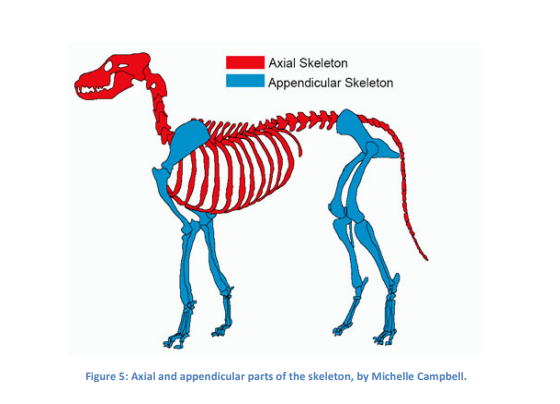
Adaptations for appendicular locomotion
Appendicular swimmers generally have adaptations to their limbs, which generate more thrust. Some, like ducks and beavers, have webbing between their toes, which increases the surface area of their feet. Another, more effective adaptation to increase propulsion is the flipper. Almost all aquatic and semi-aquatic amniotes have developed flippers, which are limbs specially adapted to generate thrust in water.
Flippers: Terrestrial vs aquatic limbs
Compared to a terrestrial limb, such as your own hand, the bones in a flipper are flatter, and the humerus, radius, and ulna are often proportionally shorter. On the other hand, the phalanges, or finger bones, are proportionally longer and/or more numerous.
Adaptations for axial locomotion
Animals that swim using their axial skeletons tend to develop specializations along regions of their spinal column- especially the tail. In order to generate more thrust from tail movement, whales and manatees have caudal flukes (Figure 11) that increase the surface area of their tails. The caudal fluke sits at the end of the tail supported by the vertebrae. I
What are caudal flukes made of and example
It is made out of concentrated bundles of a dense, fibrous connective tissue called collagen. Sea snakes have also evolved a flattened, paddle-like fluke that increases the amount of thrust their tails generate as they undulate.
Do fish have caudal flukes?
No. Fish also have a thrust-generating tail, but it is considered a caudal fin (not a caudal fluke), because it is supported by thin bones instead of collagen.
Three major types of axial locomotion
(A) Anguilliform, (B) Thunniform, and (C) Carangiform.
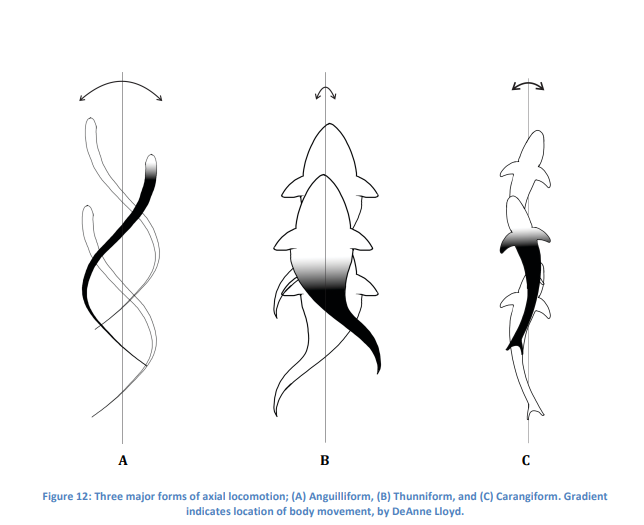
Anguilliform
describes a motion where the propulsive wave originates at or near the head, and then ripples down the entire body. It is most obvious in sea snakes and can also be seen in eels. Anguilliform swimmers tend to be very long and skinny.
Thunniform
is seen in several kinds of high-speed predatory fish like tuna and sailfish, and also in some dolphins. Thunniform swimmers begin their undulatory wave at or just in front of the caudal fin or flukes, so the body doesn’t oscillate during swimming. We tend to see broad, torpedo-shaped bodies and crescent-shaped fins and flukes in thunniform swimmers.
carangiform
In this kind of locomotion, the undulatory wave starts somewhere in the back half of the animal, but not quite at the tail fluke. Seals, crocodiles, marine iguanas, and many kinds of whales swim using this mode of locomotion.
Stability: Controlling Movement in a 3D Environment
aquatic animals move in three dimensions and have to be stable in three dimensions instead of just two. A fully aquatic animal needs to be able to control three types of motion—roll, pitch, and yaw.
roll, pitch and yaw
Pitch: up and down motion
Yaw: Left-Right motion
Roll: how much they roll; rotational movement around the longitudinal axis
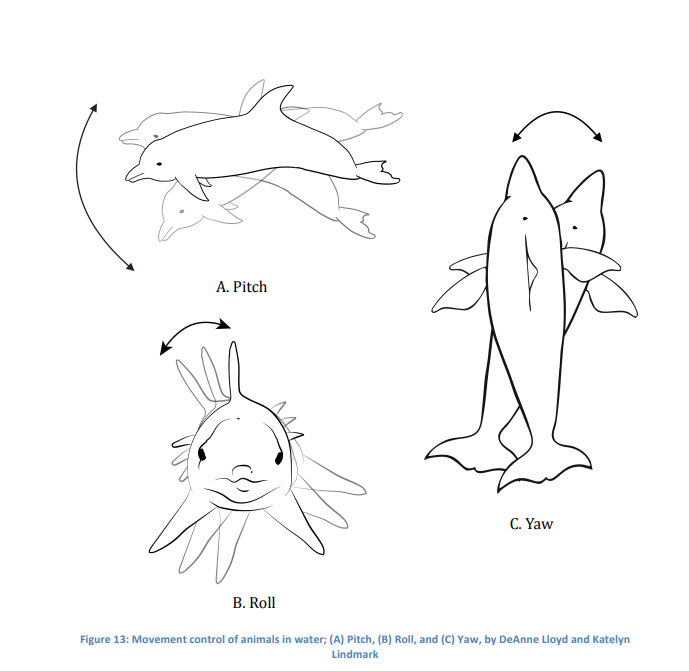
High density of water and problem of drag
Drag resists the movement of objects through any medium and is increased by both higher density and viscosity. Air is much less dense and viscous than water, so moving through it causes much less drag.
Two types of drag aquatic animals experience in water
inertial and viscous drag
Streamlined
An object that decreases inertial drag by minimizing disturbance to the water is described as streamlined.
How to minimize inertial drag?
a body should be shaped so that it disturbs the water as little as possible as it passes through. Less disturbance means less swirling water, less suction, and therefore less wasted energy and decreased speed.This can be achieved by having a smooth, elongated shape that allows for a more laminar flow of water around the object.
Negative effects of streamlining
Streamlining adaptations also include the loss of hind limbs and external ears. Different aquatic animals may be less elongate and smooth, but we tend to see some degree of streamlining in amniotes that spend a lot of time in the water.
are density and viscosity related when it comes to drag?
Inertial drag is affected by density, and viscous drag is affected by viscosity. It is important to remember that density and viscosity are unrelated characteristics and that a higher density does not always mean a higher viscosity. (example honey and water)
animal weight on land vs water
On land, all of an animal’s weight is carried by its feet, but in the oceans, water supports an animal’s body on all sides. A terrestrial skeleton needs to be very strong and heavy to support an animal’s weight. But, in water, a much smaller, more loosely attached skeleton can support a much larger body. This is the reason that the largest animals on Earth are found in the oceans. Palaeontology: Ancient Marine Reptiles 16 In fact, whales’ bodies are supported so well by the water that their skeletons cannot support them on land. If they get washed onto a beach, they will suffocate under their own sheer mass as it crushes their lungs.
Aquatic amniote strategies for staying underwater: Crocodiles
Theycan tolerate much higher levels of lactic acid in their blood, which is formed when amniotes do strenuous activity without getting enough oxygen.
Aquatic amniote strategies for staying underwater: whales
They take a series of rapid breaths at the surface to supercharge their blood and muscles with oxygen. Then, they use the oxygen stored in their blood, rather than air in the lungs, to maintain their muscle activity during deep dives.
Aquatic amniotic strategies for staying underwater: penguins
slow their heart rate when they dive, so that blood doesn't move around the body as fast, and the oxygen is used slower. They also have an amazing ability to divert blood away from some organs and towards more critical areas when their oxygen levels are depleted.
The need to surface for air and skull shape adaptations
In most terrestrial amniotes the nostrils, or nares, are located towards the tip of the snout. In many aquatic amniotes the nares migrate towards the eyes or the top of the head so that the animal only has to lift a little bit of its body above the water in order to breathe.
Nares/nostrils in marine mammals
In marine mammals, these dorsally positioned nostrils are called the blowhole. However, this is not the case for every aquatic amniote. For instance, crocodiles’ nares are on the tip of the snout.
Why do humans and other amniotes float in the water?
Human bodies have about the same density as water, but we also have a lot of air in our bodies, especially in our lungs, which causes us to float. The same is true for most other amniotes.
But marine amniotes don’t want to float; they need to move up and down in the water easily in order to find food.
Two ways aquatic amniotes increase the body density by increasing skeleton mass
pachyostosis and osteosclerosis
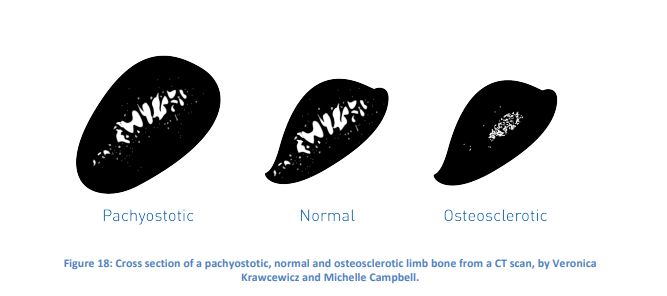
Pachyostotic bones are found in
Manatees, penguins, and some of the earlier relatives of whales.These thick bones have a much higher mass than those of terrestrial animals, thus increasing an animal’s density and achieving neutral buoyancy.
Osteosclerosis
This is where the bones stay the same size, but get much denser through the deposition of minerals in the inner cavities of the bones.
Osteoclorisis is seen in
Walruses and turtles
Crocodilians and some semi-aquatic birds use a completely different method for maintaining neutral buoyancy by
swallowing stones, known as gastroliths, in order to increase their mass. This additional mass within their stomachs increases the overall density of the animal’s body and helps them achieve neutral buoyancy
So how do amniotes that live in the ocean replenish the fluids lost through breathing and urination, without having access to fresh water?
Marine mammals are able to concentrate and excrete salt in their urine at much higher levels than most terrestrial mammals. These glands concentrate salt from the blood so that it can be expelled in drips of water.
Animals that have independently evolved a special salt gland in their heads.
Sea turtles, marine iguanas, saltwater crocodiles, penguins, and some seabirds
Better conductor between water and air?
Water is that it is a really good heat conductor. It moves heat 24 times faster than air. This means that you would get cold 24 times as fast, and that you are in 24 times as much danger of getting hypothermia.
Adaptations for staying warm
Layer of fat, Blubber (whales), fur to maintain body heat, guard hairs, water repelling oil coats on birds, reptiles don’t generate their own body heat, metabolism is slower in cold temperatures and better in warm, and sea turtles adapted a slower metabolism
How does light behave in water?
Light bends and refracts, losing intensity as it penetrates deeper. This affects visibility and color perception underwater. Light gets absorbed by water molecules and scattered by suspended particles. This means that light doesn't travel as far as it does in air, resulting in a restricted visual range
Water acts like a light filter, stripping away greater portions of the visible spectrum of light with increasing depth. Warm colors like red and orange barely penetrate the water at all, while greens and blues penetrate deepest. Only 50% of light is able to penetrate to 10 metres, only 12.5% by 30 metres, and by 200 metres, there is total darkness. And that is in totally clear water! It is even worse if the water is cloudy.
Common eye modificiations of aquatic amniotes
proportionally larger eyes than their terrestrial relatives, allowing them to pick up more of the limited amount of light that penetrates through the water.
The lens of the eye also tends to become enlarged and almost spherical, adapted for focusing on light that bends as it enters the water.
Often, aquatic amniote eyes contain high numbers of rod cells, which are the photoreceptor cells that are most sensitive to low light levels.
the development of a lining on the back of the eyes called the tapetum lucidum
tapetum lucidum
The reason cat’s eyes glows in the dark
acts like a mirror, reflecting incoming light back through the retina a second time, increasing the light gathering ability of the rod cells, even in low light conditions. This adaptation is seen in semi-aquatic amniotes such as seals and crocodiles.
Hearing underwater
Hearing underwater, unlike sight, actually functions better than it does on land. Sound travels more efficiently through higher density mediums, traveling much farther, and up to 5 times faster in seawater than in the air!
Hearing on-land vs underwater
On land, sound vibrations strike the amniote eardrum through an air-filled, outer ear canal. But when a typical land animal is submerged, water fills the ear canal, decreasing the ability to hear. Underwater, it is much more common to pick up the vibrations caused by sound through the skull bones, a phenomenon called bone conduction(this is what humans do).
Hearing adaptations
The evolution of large bony plates in the ears facilitates the detection of sounds using bone conduction. The plates transmit sound to the inner ear with less distortion and also allow the animal to detect the direction that the sound came from. Marine animals rely on sound to sense their surroundings, communicate, locate food and protect themselves using Echolocation
Mesozoic era
This era is comprised of the Triassic, Jurassic and Cretaceous periods, when the dinosaurs lived on the land, and the pterosaurs soared through the air.
Three most successful extinct marine reptile clades, in the Mesozoic
ichthyopterygians, sauropterygians, and mosasauroids
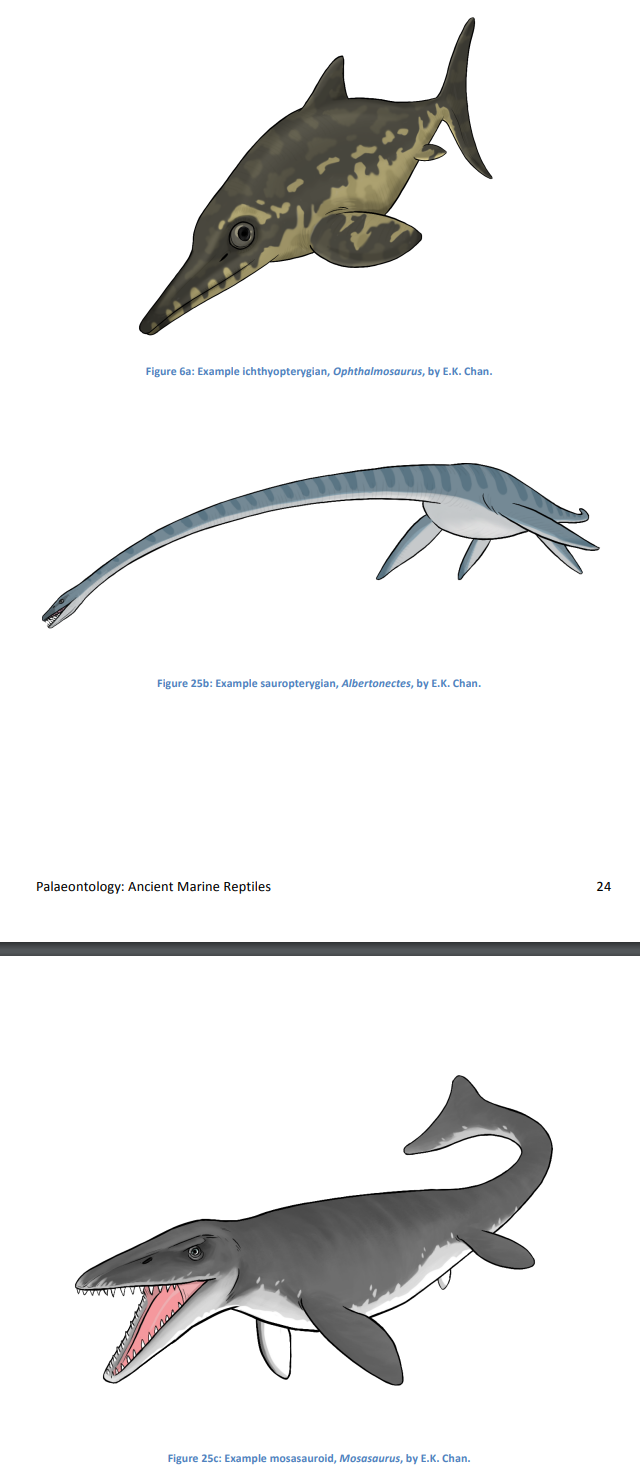
basal and derived members
The evolutionary stages of species, where basal members are more primitive/earliest and derived members, seen later, exhibit more advanced traits. On your phylogenetic trees, the basal members are always found near the base of that group’s branch. The derived members are found on the end of the branches.
Two major groups of amniote evolution and how we recognize them
These groups can be recognized by the number of temporal fenestrae in their skulls: Synapsida includes all mammals & Sauropsida including parareptiles
Temporal fenestrae
openings/holes in the skull behind the eyes that differentiate major amniote groups.
Temporal fenestrae synapsida
have one temporal fenestra behind each eye, distinguishing them from other amniotes.
Sauropsida
includes the parareptiles, which show the anapsid skull condition, with no extra openings behind the orbit
other clade in sauropsida
diapsida: These animals have two openings called the laterotemporal and supratemporal fenestrae, which you can see on the skull on the right. The diapsids are the most diverse group and include birds, crocodiles, and lizards, all of which have two temporal fenestrae.
Living diapsids divided into two clades
The Archosauromorpha, known as the ruling reptiles, have additional fenestrae in front of the eye and on the jaw. The Lepidosauromorpha, or scaly reptiles, lack those openings
Archosauromorpha: Living and extinct members
Living: Birds & Crocodiles
Extinct: dinosaurs, pterosaurs, and many relatives of today's crocodilians.
Lepidosauromorpha: Living and extinct groups
The living members include snakes and lizards, but this group also included many other marine reptiles
Extinct Marine Reptile Groups
Mesosaurs
Crocodylomorpha
Tanystropheidae
Drepanosauridae
Choristoderes
Tangasauridae
Atopodentatus
Turtle placement
Turtles have anapsid skulls without temporal fenestrae. This would normally indicate that they are parareptiles. However, many palaeontologists have suggested that they are an early branch of diapsids who have lost their temporal fenestrae, converging on the anapsid condition. Recent genetic analyses have hypothesized that they are closely related to the Crocodylomorpha. (for this course: amniotes)
Odontochelys & Archelon
The oldest fossil turtle, Odontochelys, is from the Triassic of China. Odontochelys is unusual compared to today's turtles: it still possessed teeth and only had a partial shell protecting its belly.
In the Late Cretaceous, an extinct lineage of turtles produced the largest marine turtle that ever lived, called Archelon, which grew to lengths of more than 4 meters, and would have looked a lot like a modern day leatherback sea turtle.
Cephalopoda
A group of invertebrates that was much more abundant and diverse in the Mesozoic. Today, cephalopods are represented by squid, octopus, cuttlefish, and the nautilus. However, the Mesozoic seas were full of many other species that are now extinct, including ammonites and belemnites.
Ammonites
would have resembled modern day nautiluses in many ways. The soft, squidlike part of their body would have resided partly within the coiled shell, which was composed of many chambers. Nautiluses can control gases within these chambers in order to regulate their buoyancy in the water, and spend their lives in the open ocean feeding on small prey in the water column. Most ammonites probably had a similar lifestyle, but their shells were often more elaborate than the smooth shell of the nautilus, with lots of bumps and ridges.
Belemnites
more closely resembled squid and cuttlefish and had an elongate internal shell, usually shaped like a fat pencil. Fossilized gut contents for several marine reptile specimens show that cephalopods were a major part of the diet in many species.